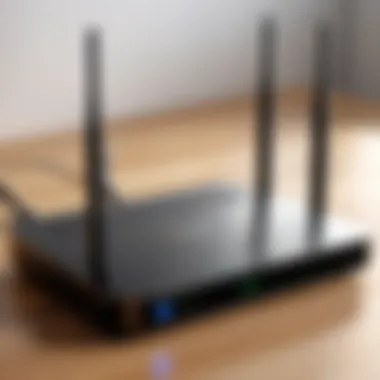Understanding Your IP Address and Routers


Intro
Understanding one's IP address is crucial in the ever-evolving landscape of digital communication. Your IP address serves as the unique identifier for your device within a network, representing not only your connection to the internet but also the gateway to a plethora of cyber security considerations. Routers, integral to this equation, facilitate the exchange of information between devices and the internet, acting as both bridges and gatekeepers.
In this article, we will explore the nuances of IP addresses in relation to routers, breaking down the complexities into digestible segments. The objective is to ensure that individuals can grasp the essential concepts and practical implications of their IP address. Whether you are troubleshooting a network issue or simply seeking to understand the elements that contribute to your online presence, this article aims to equip you with the necessary knowledge.
To embark on this journey, we will discuss the types of IP addresses, delving into the distinctions between public and private addresses. We will also highlight the operational role of routers, followed by practical guidance on locating your router's IP address. Through detailed analysis and straightforward instructions, this exploration promises clarity and insight into the often-overlooked aspect of your online identity.
Prolusion to IP Addresses
Understanding IP addresses is crucial in the context of networking and routers. An IP address, or Internet Protocol address, serves as a unique identifier for devices connected to a network. This section aims to clarify the foundational concepts surrounding IP addresses, emphasizing their practical applications and significance in today's interconnected world.
What is an IP Address?
An IP address is essentially a numerical label assigned to each device connected to a computer network. It enables devices to communicate with each other over the internet. Without it, the routing of data packets would be impossible. IP addresses are structured in a way that allows routers to direct traffic efficiently. The understanding of IP addresses forms the core of network management.
Types of IP Addresses
IP addresses can be categorized into two main types: public and private. Each type has distinct functionalities and uses in network environments.
Public IP Address
Public IP addresses are assigned by Internet Service Providers and are accessible from the internet. Their primary attribute is to serve as a unique identifier for devices on the wider internet. When you send or receive data online, it is your public IP address that is recognized by other devices. This makes it a vital aspect of internet connectivity. While public IPs allow access to global networks, they also expose your device to potential security risks, making proper network security strategies essential.
Private IP Address
Private IP addresses, on the other hand, are designated for use within a local network. This means they are not routable on the internet, providing a layer of security. These addresses enable devices like computers and printers to communicate within the same network while maintaining isolation from external access. This characteristic makes private IP addresses beneficial for home and office networks, fostering a secure environment for device communication.
Static vs. Dynamic IP Address
Static IP addresses are fixed and do not change over time, while dynamic IP addresses are assigned temporarily by a Dynamic Host Configuration Protocol (DHCP) server. The advantage of static IP addresses lies in their consistency, which is beneficial for hosting services, enabling reliable remote access, and reducing the complexity of network routing. Conversely, dynamic IP addresses simplify the management of users on a network, automatically reallocating addresses as devices connect or disconnect. Each type has its own set of advantages depending on specific use cases.
Role of Routers in Networking
Understanding the role of routers is essential for anyone who engages with modern networking systems. Routers serve as the critical junctions where data travels between networks, including local area networks (LANs) and wide area networks (WANs). Their primary function is to direct internet traffic efficiently, ensuring data packets reach their destination while maintaining the integrity and speed of the connection. This article will explore how routers function, the management of IP addresses, and why these elements are significant for your network configuration and security.
What is a Router?
A router is a networking device that forwards data packets between computer networks. It utilizes headers and forwarding tables to determine the best path for data transmission. Routers can connect different networks, such as connecting a home network to the internet. They often contain multiple ports, enabling connections to several devices at once.
Network protocols such as Internet Protocol (IP), are critical for routers to determine where to send data. Depending on the complexity of a network, routers can be simple consumer-grade devices or sophisticated enterprise models that manage connections for large institutions.
How Routers Manage IP Addresses
Routers play a vital role in the management of IP addresses within a network. Each device connected to a router requires a unique IP address to communicate effectively.


Routers typically assign devices an IP address through three primary methods:
- Dynamic Host Configuration Protocol (DHCP): This is the most common method used in home networks. In this case, the router automatically assigns IP addresses to devices as they connect. These addresses may change over time, which is essential for optimal device management.
- Static IP Address Assignment: Some users prefer setting a static IP address for devices that require constant addressing, such as printers or servers. This method avoids the potential confusion that can occur with dynamic assignments.
- Address Resolution Protocol (ARP): This is a communication protocol used for discovering the link layer address of a host given its internet layer address. Routers use ARP to maintain an accurate record of which IP addresses correspond to which physical hardware addresses.
By managing IP addresses, routers ensure that data packets are sent to the correct destination within a network, allowing seamless connectivity and functionality. This management is also crucial for implementing security measures and diagnosing issues within the network.
"The performance and security of any network heavily rely on the efficiency with which routers handle IP addresses."
Finding Your Router's IP Address
Knowing your router's IP address is essential for various reasons. First, it allows you to access the router's configuration settings, where adjustments can be made for security and performance. If you encounter connectivity issues or need to modify network configurations, identifying the router's IP becomes crucial. Furthermore, understanding your router's IP address can help in troubleshooting network problems. The following sections will detail practical methods to find your router's IP address using different operating systems and devices, enhancing your ability to manage your network effectively.
Using Command Prompt on Windows
To find your router's IP address through the Command Prompt in Windows, follow these steps:
- Click on the Start menu and type "cmd" in the search bar.
- Select the Command Prompt from the results.
- Type and hit Enter.
This command will display the network configuration details. Look for the line labeled Default Gateway under your active network connection. The number next to it is your router’s IP address. This method is straightforward and effective, allowing you to retrieve the information in just a few moments.
Using Terminal on MacOS
For MacOS users, the Terminal is another effective tool to find your router's IP address. Here’s how you can do this:
- Open the Spotlight Search by pressing Command + Space.
- Type "Terminal" and press Enter.
- In the Terminal window, type and press Enter.
The output will show the router's IP address next to the word "default". This method is also quite reliable and is often preferred by Mac users who are comfortable using command-line tools.
Accessing Router Settings via Web Browser
Accessing the router settings through a web browser allows for a more interactive exploration of your router's configuration. Here are steps to follow:
- Open a web browser.
- In the address bar, type your router's IP address as found using the methods above.
- Press Enter. This will redirect you to the router’s login page.
Default Gateway
The Default Gateway is the IP address that your devices use to communicate with the router. It is critical for your network because it serves as the main access point for all connected devices. If you have multiple routers, each will have its own unique default gateway. Knowing this IP is beneficial because it facilitates network configuration, monitoring, and troubleshooting processes. Most routers have a default gateway IP of either 192.168.1.1 or 192.168.0.1, making it a popular choice in home networking.
Router Login Credentials
Router Login Credentials are the username and password needed to access the router settings. Typically, these come pre-configured by the manufacturer. However, for security, it is advisable to change these upon setup. The importance of these credentials cannot be overstated, as they protect your network settings from unauthorized access. Setting unique credentials not only enhances security but also ensures that only authorized users can modify network settings. Still, it's common practice to find default usernames and passwords available online, which can pose security risks if left unchanged.
Understanding Network Configuration
Understanding network configuration is a foundational aspect of effectively managing and using your Internet Protocol (IP) address. Network configuration involves setting up the hardware and software to ensure that devices can communicate seamlessly through a router. Proper configuration enhances connectivity, speeds up data transmission, and ensures security against potential threats. Without it, you may face numerous issues such as slow connections, limited access, and even security risks. Thus, comprehending the nuances of network configuration is not merely a technical exercise; it is essential for any user keen on optimizing their home or office network.
Importance of Network Configuration


Network configuration encompasses the parameters and settings that govern how devices interact within a network. Especially in today’s digital age, where numerous devices are connected at once, understanding this concept allows for more efficient use of resources. A well-configured network ensures that data packets are routed correctly, avoiding bottlenecks and enhancing overall system performance. Additionally, it plays a role in determining the extent of security measures one can implement. Understanding this allows for more informed decisions regarding firewalls, encryption, and device management, effectively shielding your IP address from potential threats.
Common Network Settings
Configurations can vary based on the type of network being utilized. However, some settings are common across most systems.
- IPv4 vs. IPv6:IPv4 has been the standard for many years and uses a 32-bit addressing scheme. This limits the total number of unique addresses to about 4.3 billion. Given today’s increasing number of devices, this scarcity has led to the adoption of IPv6, which employs a 128-bit addressing scheme allowing for a virtually limitless number of IP addresses.The key characteristic that makes IPv6 a beneficial choice is its ability to accommodate a vastly growing network, especially with Internet of Things (IoT) devices proliferating every day. Another advantage is improved routing efficiency and simplified address configuration. However, IPv4 is still prevalent due to widespread compatibility and existing infrastructure.
- DHCP and Static IP Assignment:Dynamic Host Configuration Protocol (DHCP) simplifies IP assignment within networks by automatically assigning IP addresses to devices. This process is beneficial as it reduces the need for manual configuration and is particularly advantageous in networks with many devices.On the other hand, static IP assignment can be important for devices that require a consistent address, such as servers or printers. The uniqueness of a static IP is its permanence, which is critical for tasks like hosting websites or accessing devices remotely. However, managing a static IP can become cumbersome in larger networks, increasing the potential for errors.
Understanding these settings will better equip you to manage your network and troubleshoot potential issues that arise with your IP address. Configuration is not just a one-time task; it requires constant adjustment as the needs of the network evolve.
Troubleshooting IP Address Issues
Understanding how to troubleshoot IP address issues is essential for maintaining a smooth and secure network. Problems with IP addresses can lead to various complications including loss of connectivity, inability to access certain websites or services, and potential security vulnerabilities. By effectively identifying and resolving these issues, users can enhance the performance of their network and safeguard their online presence.
Identifying Common Problems
Common IP address issues often manifest in several ways. Users may find they cannot connect to the internet or receive error messages indicating problems with their network configuration. Here are some typical problems:
- Incorrect IP Configuration: Sometimes, a device may become misconfigured, leading to issues like not obtaining an IP address from the router.
- Network Disruptions: Temporary outages or disruptions can prevent devices from connecting properly, causing frustration.
- Multiple Devices: When several devices are connected at once, it can result in network strain or address conflicts that disrupt normal operations.
Recognizing these problems quickly can save time and effort in resolving them. Understanding that these issues often stem from a few common root causes is the first step in troubleshooting effectively.
Resolving IP Conflicts
IP conflicts occur when two devices on the same network are assigned the same IP address. This leads to communication issues, as data packets cannot reach their intended destination. To resolve IP conflicts, consider these steps:
- Reboot Devices: A simple reboot of the affected devices often clears the conflict.
- Release and Renew IP Address: For devices using DHCP, this can be done through the command prompt. On Windows, enter the following commands:
- Manual Configuration: If the problem persists, manually assign IP addresses to devices ensuring they are unique within the network.
By taking these actions, users can restore their network's functionality and ensure efficient communication between devices.
Steps to Reset Router
Resetting a router can often resolve various network issues, including IP address problems. However, it should be done cautiously as it will erase all customized configurations. Here are the steps:
- Locate the Reset Button: Most routers have a small reset button. It is often found on the back of the device.
- Press and Hold: Use a paperclip or a similar object to press and hold the reset button for about 10 seconds or until the lights on the router blink.
- Reconnect and Reconfigure: Once the router has reset, reconnect devices and reconfigure settings such as Wi-Fi name and password.
Being proactive about troubleshooting IP address issues allows users to maintain a healthy network environment. By following the outlined steps and recognizing signs of common problems, they can enhance their online security and experience.
IP Address Security Considerations
In today's digital world, understanding the security aspects of your IP address is crucial for maintaining privacy and ensuring safe internet usage. An IP address serves as your unique identifier on the network, revealing valuable information about your online activities. This openness also presents various risks that can compromise your security. Recognizing these risks allows users to take proactive measures in protecting their data.
Risks Associated with IP Addresses


Recognizing the risks linked with IP addresses is the first step in protecting your online identity. Some key risks include:
- Target for Attackers: Cybercriminals can exploit your IP address to launch attacks, including DDoS (distributed denial-of-service) attacks, which aim to overwhelm your network.
- Geolocation Information: Your IP address can reveal approximate geographical location. This information can be used maliciously, for example, to target specific regions with phishing attacks.
- Data Interception: Without proper safeguards, your data might be intercepted by third parties while transmitting over the network. This could include sensitive information such as passwords and banking details.
Protecting your IP address is not just about technology; it's about safeguarding your personal and financial data.
Protecting Your IP Address
Several methods can enhance the security of your IP address, ensuring better protection while browsing the internet. Two prominent strategies are:
Using a VPN
A Virtual Private Network (VPN) creates a secure and encrypted connection over a less secure network, such as the Internet. The main characteristic of a VPN is its ability to mask your IP address, redirecting your internet traffic through a server located elsewhere. This is beneficial because:
- Privacy Enhancement: By using a VPN, your real IP address is hidden from websites and potential attackers, greatly reducing the risk of targeted attacks.
- Bypass Restrictions: VPNs allow users to access geo-restricted content by connecting to servers in different countries.
However, a VPN is not without its disadvantages. The key feature that users may find an annoyance is the potential decrease in internet speed and connectivity issues, as your data takes a longer route through the VPN server.
Network Firewalls
Using network firewalls is another effective way to protect your IP address. Firewalls serve as barriers between your internal network and external threats. Their key characteristics include:
- Traffic Control: Network firewalls monitor and filter incoming and outgoing traffic based on predetermined security rules. This control helps to prevent unauthorized access.
- Threat Detection: A firewall can block malicious traffic before it reaches your network, significantly reducing the risk of data breaches.
Firewalls can also have downsides, such as requiring technical knowledge for proper setup and configuration. If misconfigured, they can cause disruptions in connectivity or limit legitimate access to resources.
Understanding these aspects allows you to take steps in ensuring the security of your IP address. Through effective use of tools like VPNs and firewalls, you can enhance your online privacy and fend off potential threats.
Finale
The conclusion of this article serves as a powerful summary that encapsulates the critical elements associated with understanding IP addresses and their relation to routers. The significance of grasping how IP addresses function cannot be overstated, particularly as the digital landscape grows increasingly intricate. It is a fundamental aspect of network management and an essential skill for both everyday users and tech enthusiasts.
In this article, we have explored various facets of IP addresses, including their definitions, types, and the complexities involved in their management through routers. We discussed the importance of locating one's router IP and the security implications surrounding it. Recognizing how to troubleshoot common IP-related issues enhances one’s confidence in navigating network environments.
Furthermore, the article emphasized various security considerations regarding IP addresses, revealing vulnerabilities and protective measures such as using Virtual Private Networks (VPNs) and firewalls. These discussions are not merely academic; they have practical implications for anyone concerned with online security, as today’s threats are ever-present and evolving.
Readers now possess a solid foundation to take charge of their network settings, considering not only how to effectively manage their IP addresses but also the critical security practices required to protect their information in a digital society.
"Staying informed about how your IP address and routers interact can significantly enhance your online security and user experience."
Recognizing the interplay between networking elements enables individuals to guard against unauthorized access and data breaches.
Summary of Key Points
- IP addresses are crucial for online communication and interaction between devices. Understanding their types, such as public and private IP addresses, is essential.
- Routers play a central role in managing these addresses effectively, enabling connectivity within and outside of local networks.
- Identifying your router’s IP address allows you to configure settings essential for leveling up security and performance.
- Troubleshooting skills are invaluable. Knowing how to identify, resolve, and prevent IP conflicts can save time and resources.
- Security cannot be overlooked. Measures like VPNs and firewalls are paramount for safeguarding personal information in the digital realm.
Future Considerations
Looking ahead, the realm of IP addressing and routing will continue to evolve with technology. As the Internet of Things (IoT) becomes more prevalent, the number of devices requiring IP addresses will surge. This shift presents both opportunities and challenges.
- IPv6 adoption is becoming increasingly necessary due to the scant availability of IPv4 addresses. Understanding the implications of this transition will be vital for anyone involved in networking.
- Continuous education on cybersecurity trends related to IP addresses will help users stay one step ahead of potential threats. As techniques for unauthorized access evolve, so must our security protocols.
- Integration with emerging technologies, such as cloud computing and AI-driven networking solutions, raises numerous possibilities for enhanced networking. Familiarity with these advancements will be critical for future IT landscapes.
In summary, the dynamics of networking and the management of IP addresses will demand our attention and adaptability. Staying informed and proactive will ensure that both personal and organizational networks remain secure and effective.







